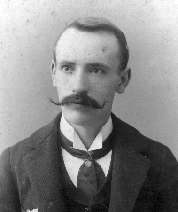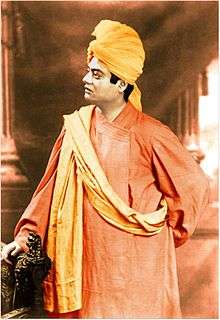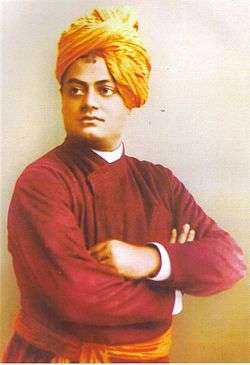J. J. Goodwin
| Josiah John Goodwin | |
|---|---|
 | |
| Born |
20 September 1870 Batheaston, England |
| Died | 2 June 1898 (aged 27) |
| Nationality | British |
| Occupation | Stenographer |
Josiah John Goodwin (20 September 1870 – 2 June 1898) was a British stenographer and a disciple of Indian philosopher Swami Vivekananda. Goodwin is known for recording Vivekananda's speeches, and it is thought that without his efforts most of Vivekananda's works would have been lost.[1][2]
During his lecture tour in the United States, Vivekananda's disciples could not find a stenographer who could keep pace with his rapid speech. Therefore, his friends and admirers engaged a very expensive court-reporter, J. J. Goodwin.
Early life and early career
Goodwin was born on 20 September 1870 at Batheaston, England.[3] His father Josiah Goodwin was a stenographer and an editor of the Birmingham Advertiser, the Wilts Country Mirror and the Exeter Gazette. Goodwin worked as a journalist from the age of fourteen, and had an unsuccessful journalistic venture in Bath in 1893. He left Bath and travelled to Australia, and later on, to America.[4]
Relationship with Swami Vivekananda

After his influential speech at the 1893 Parliament of the World's Religions, Swami Vivekananda travelled around America on a lecture tour. During the tour, Vivekananda's admirers wished to record his lectures and an advertisement was published in December 1895 in two New York newspapers, the Herald and the World. In response to the advertisement, twenty-five-year-old Goodwin applied for the job.[5] He became one of Vivekananda's staunchest followers and played an important role in recording Vivekananda's ex tempore speeches. After the first week Goodwin refused any money, saying, "If Vivekananda gives his life, the least I can do is to give my service." He accepted only what was necessary for his basic subsistence.[6] Goodwin was a hard worker amidst Vivekananda's strenuous schedule: after taking the lectures stenographically, he would type them and hand over the manuscript to the newspapers and Brahmavadin and used to get prepared for the same work on the following day.[7]
In August 1898, Swami Vivekananda wrote the poem Requiescat in pace in memory of Goodwin. The poem began:[8]
Speed forth, O soul! upon thy star-strewn path,
Speed, blissful one, where thought is ever free,
Where time and sense no longer mist the view,
Eternal peace and blessings be on thee!
Death
Goodwin died on 2 June 1898 at the age of 27. Soon after Vivekananda, who was in India at that time, was informed about it. Very recently, in the same year, Vivekananda had received the news of Indian yogi Pavhari Baba's death too. According to Vivekananda researcher Pravrajika Vrajaprana after receiving the death news of Goodwin, Vivekananda was "visibly disturbed".[9]
In August 1898 Vivekananda wrote in tribute:[10]
With infinite sorrow I learn the sad news of Mr. Goodwin's departure from this life, the more so as it was terribly sudden and therefore prevented all possibilities of my being at his side at the time of death. The debt of gratitude I owe him can never be repaid, and those who think they have been helped by any thought of mine ought to know that almost every word of it was published through the untiring and most unselfish exertions of Mr. Goodwin. In him I have lost a friend true as steel, a disciple of never-failing devotion, a worker who knew not what tiring was, and the world is less rich by one of those few who are born, as it were, to live only for others.
References
- ↑ Jeshi, K (9 December 2008). "A labour of love". The Hindu. Retrieved 10 October 2009.
- ↑ Badrinath 2006, pp. 79
- ↑ "Goodwin batheaston". JJ Goodwin website. Archived from the original on 1 July 2013. Retrieved 1 July 2013.
- ↑ Vrajaprana 1999, pp. 7–9
- ↑ Vrajaprana 1999, pp. 4–6
- ↑ "Publisher's note" in Vrajaprana 1999, p. i, p.11
- ↑ Vrajaprana 1999, pp. 12–13
- ↑ "Requiescat in pace". Vivekananda.net. Archived from the original on 1 July 2013. Retrieved 1 July 2013.
- ↑ Vrajaprana 1999, p. 1
- ↑ Badrinath 2006, pp. 393–394
Bibliography
- Vrajaprana, Pravrajika (1999). My Faithful Goodwin. Advaita Ashrama. ISBN 8185301255.
- Badrinath, Chaturvedi (2006). Swami Vivekananda: The Living Vedanta. Penguin Books India. ISBN 978-0-14-306209-7.
